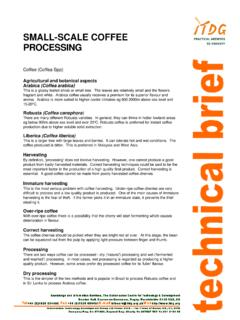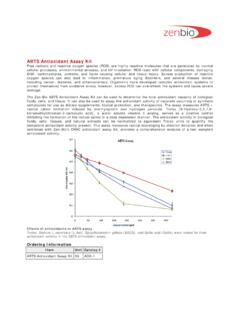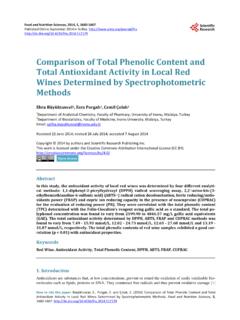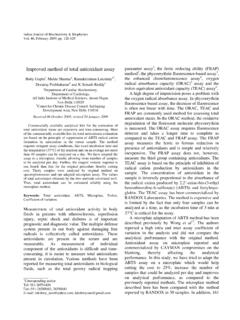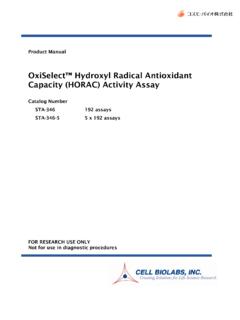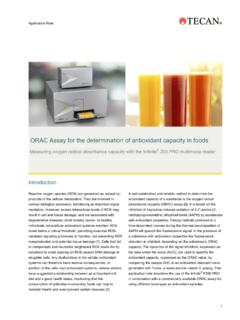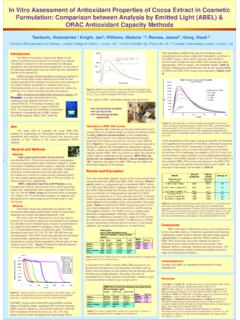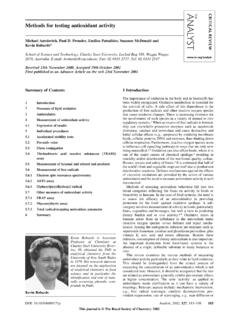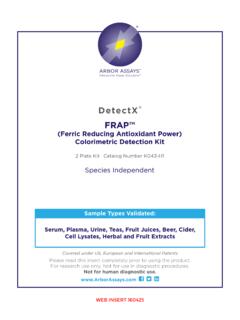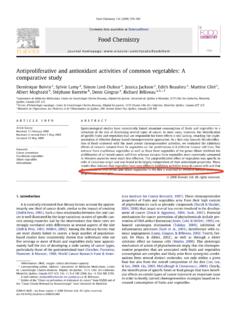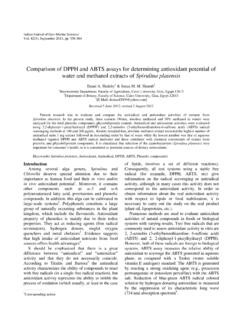Transcription of Original Article Comparison of ABTS, DPPH, FRAP, and ORAC ...
1 JOURNAL OFFOOD COMPOSITIONAND ANALYSISJ ournal of Food Composition and Analysis 19 (2006) 669 675 Original ArticleComparison of ABTS, DPPH, FRAP, and ORAC assays for estimatingantioxidant activity from guava fruit extractsKriengsak Thaiponga, Unaroj Boonprakoba, , Kevin Crosbyb,Luis Cisneros-Zevallosc, David Hawkins ByrnecaDepartment of Horticulture, Kasetsart University, Kamphaengsaen Campus, Nakhon Pathom 73140, ThailandbDepartment of Horticultural Sciences, Texas A&M Research & Extension Center, Weslaco, TX 78596, USAcDepartment of Horticultural Sciences, Texas A&M University, College Station, TX 77843-2133, USAR eceived 28 March 2005; received in revised form 5 January 2006; accepted 10 January 2006 AbstractGuava fruit extracts were analyzed for antioxidant activity measured in methanol extract (AOAM), antioxidant activity measured indichloromethane extract (AOAD), ascorbic acid, total phenolics, and total carotenoids contents.
2 The ABTS, DPPH, and FRAP assayswere used for determining both AOAM and AOAD, whereas the ORAC was used for determining only AOAM. Averaged AOAM [mMTrolox equivalent (TE)/g fresh mass (FM)] were , , , and as determined by the ABTS, DPPH, FRAP, and ORAC assays, respectively. Averaged AOAD (mM TE/g FM) were , , and as determined by the ABTS, DPPH, and FRAP assays,respectively. AOAM determined by all assays were well correlated with ascorbic acid ( ) and total phenolics ( )and also among themselves ( ) but had negative correlation with total carotenoids ( ).r2006 Elsevier Inc. All rights :Ascorbic acid; Phenolic; Carotenoid;Psidium IntroductionNatural antioxidants , particularly in fruits and vegeta-bles have gained increasing interest among consumers andthe scientific community because epidemiological studieshave indicated that frequent consumption of naturalantioxidants is associated with a lower risk of cardiovas-cular disease and cancer (Renaud et al.)
3 , 1998;Temple,2000). The defensive effects of natural antioxidants in fruitsand vegetables are related to three major groups: vitamins,phenolics, and carotenoids. Ascorbic acid and phenolicsare known as hydrophilic antioxidants , while carotenoidsare known as lipophilic antioxidants (Halliwell, 1996).Guava (Psidium guajavaL.) fruit is considered a highlynutritious fruit because it contains a high level of ascorbicacid (50 300 mg/100 g fresh weight), which is three to sixtimes higher than oranges. Red-fleshed Brazilian guava hasseveral carotenoids such as phytofluene,b-carotene,b-cryptoxanthin,g -carotene, lycopene, rubixanthin, crypto-flavin, lutein, and neochrome (Mercadante et al., 1999).Setiawan et al. (2001)reported that Indonesian guava is anexcellent source of provitamin A carotenoids. Phenoliccompounds such as myricetin and apigenin (Miean andMohamed, 2001), ellagic acid, and anthocyanins (Misraand Seshadri, 1968) are also at high levels in guava , producing guava specially bred for higher levelsof antioxidant compounds, is a realistic approach toincrease dietary antioxidant intake.
4 Evaluation in anyplant-breeding program, however, has to deal withnumerous plants, particularly at the early selection , the assay for screening germplasm and hybridsshould be simple, inexpensive, rapidly performed, andprovide a high degree of assays have been frequently used to estimateantioxidant capacities in fresh fruits and vegetables andtheir products and foods for clinical studies including 2,2-azinobis (3-ethyl-benzothiazoline-6-sulfonic acid) (ABTS) Article IN $ - see front matterr2006 Elsevier Inc. All rights Corresponding author. Tel.: 66 34 281084; fax: 66 34 (U. Boonprakob).(Leong and Shui, 2002;Miller and Rice-Evans, 1997), 2,2-diphenyl-1-picrylhydrazyl (DPPH) (Brand-Williams et al.,1995;Gil et al., 2002), ferric reducing antioxidant power(FRAP) (Benzie and Strain, 1999;Guo et al., 2003;Jimenez-Escrig et al., 2001), and the oxygen radicalabsorption capacity (ORAC) (Cao et al.)
5 , 1993;Ou et al.,2001;Prior et al., 2003). The ORAC assay is said to bemore relevant because it utilizes a biologically relevantradical source (Prior et al., 2003). These techniques haveshown different results among crop species and et al. (2002)reported no correlation ofantioxidant activity between the FRAP and ORAC techniques among most of the 927 freeze-dried vegetablesamples, whereas these methods revealed high correlationin blueberry fruit (Connor et al., 2002). Similarly,Awikaet al. (2003)observed high correlation between ABTS, DPPH, and ORAC among sorghum and its aim of this research was to compare the efficiency ofABTS, DPPH, FRAP, and ORAC assays to estimateantioxidant activities and their correlations with ascorbicacid, total phenolics, and total carotenoids contents inguava fruit Materials and Plant materialsGuava fruits were harvested at maturity from one white-fleshed ( Allahabad Safeda ) and three pink-fleshed ( FanRetief , Ruby Supreme and an advanced selection) clonesat Weslaco, TX, USA with the cooperation of Dr.
6 KevinCrosby. Whole fruit was stored at 201C for 6 monthsbefore ExtractionsFruit extracts for ascorbic acid analysis were obtained byhomogenizing 3 g of guava tissue (pulp and peel) in 20 mLcold solution of 3% (w/v) oxalic acid plus 8% glacial aceticacid (v/v) until uniform consistency, using an Ultra-Turraxhomogenizer (T25, Ika Works Inc., USA). The homo-genates were centrifuged at 15,000 rpm at 41C for 10 supernatants were recovered and ascorbic acidimmediately extracts for total phenolics and antioxidant activitymeasured in methanol extract (AOAM) analysis wereprepared using the method ofSwain and Hillis (1959),with some modifications. Three grams of guava tissue weremixed with 25 mL methanol and homogenized using theUltra-Turrax homogenizer. The homogenates were kept at41C for 12 h and then centrifuged at 15,000 rpm for 20 minusing a vacuum micro centrifuge (Beckman, J2-21, Beck-man Instruments Inc.)
7 , USA). The supernatants wererecovered and stored at 201C until analysis. The pelletwas re-dissolved with 20 mL dichloromethane and homo-genized for antioxidant activity measured in dichloro-methane extract (AOAD) analysis. The homogenates werecentrifuged at 15,000 rpm for 20 min. The supernatantswere recovered and stored at 201C until analysis. Ingeneral, methanol extraction and dichloromethane extrac-tion are used for determining hydrophilic and lipophilicantioxidant activities (Arnao et al., 2001).Fruit extracts for total carotenoids analysis wereprepared by the method ofWilberg and Rodriguez-Amaya(1995), with some modifications. Three grams of guavatissue were mixed with 20 mL ethanol hexane (1:1)solution containing 200 mg/L 2,6-di-ter-butyl-p-cresol toavoid carotenoid oxidation and then homogenized usingthe Ultra-Turrax homogenizer until uniform homogenates were filtered using a Whatman No.
8 4filter paper and re-extracted two or three times, dependingon the clone, with 20 mL solvent. The extracts were washedthree times with nanopure water. The supernatants wererecovered and added with hexane to a final volume of10 mL, and then stored at 201C until Antioxidant determinationsAscorbic acid content was determined using the 2, 6-dichlorophenol-indophenol titration method described inAssociation of Office Analytical Chemists (1996).L-ascorbic acid was used to prepare a standard solution(1 mg/mL). The ascorbic acid concentration was calculatedby Comparison with the standard and expressed as mg/100 g fresh phenolics content was determined by the Folin Ciocalteu method, which was adapted fromSwain andHillis (1959). The 150mL of extract, 2400mL of nanopurewater, and 150mL of N Folin Ciocalteu reagent werecombined in a plastic vial and then mixed well using aVortex.
9 The mixture was allowed to react for 3 min then300mLof1 NNa2CO3solution was added and mixed solution was incubated at room temperature (231C) inthe dark for 2 h. The absorbance was measured at 725 nmusing a spectrophotometer (Hewlett Packard 8452A, DiodeArray, USA) and the results were expressed in gallic acidequivalents (GAE; mg/100 g fresh mass) using a gallic acid(0 mg/mL) standard curve. Additional dilution wasdone if the absorbance value measured was over the linearrange of the standard carotenoids content was determined by thespectrophotometric method at 470 nm, which was adaptedfromTalcott and Howard (1999)using ab-carotene( mg/mL) standard curve. The total carotenoidscontent was expressed based onb-carotene equivalents (b-carotene; mg/100 g fresh mass). Additional dilution wasdone if the absorbance value measured was over the linearrange of the standard Antioxidant activity determinationsFor ABTS assay , the procedure followed the method ofArnao et al.
10 (2001)with some modifications. The stocksolutions included mM ABTSd+solution and mMARTICLE IN PRESSK. Thaipong et al. / Journal of Food Composition and Analysis 19 (2006) 669 675670potassium persulfate solution. The working solution wasthen prepared by mixing the two stock solutions in equalquantities and allowing them to react for 12 h at roomtemperature in the dark. The solution was then diluted bymixing 1 mL ABTSd+solution with 60 mL methanol toobtain an absorbance of units at 734 nm usingthe spectrophotometer. Fresh ABTSd+solution wasprepared for each assay . Fruit extracts (150mL) wereallowed to react with 2850mL of the ABTSd+solution for2 h in a dark condition. Then the absorbance was taken at734 nm using the spectrophotometer. The standard curvewas linear between 25 and 600mM Trolox. Results areexpressed inmM Trolox equivalents (TE)/g freshmass. Additional dilution was needed if the ABTS value measured was over the linear range of the DPPH assay was done according to the method ofBrand-Williams et al.





